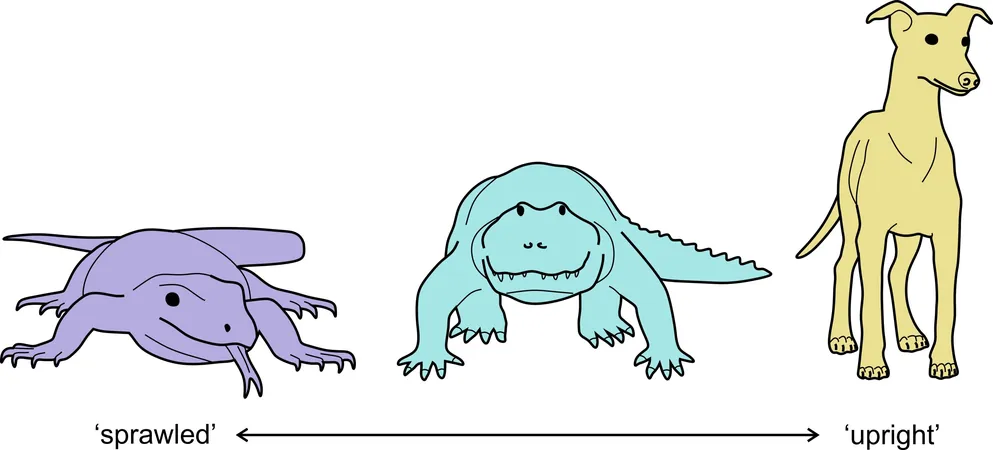
Unraveling the Evolutionary Journey: How Mammals Transitioned from Sprawled to Upright Posture
2024-10-25
Author: Jia
Introduction
Mammals, including humans, are uniquely characterized by their upright stance, a significant feature that has played a crucial role in their evolutionary success. In stark contrast, the earliest ancestors of modern mammals bore a striking resemblance to reptiles, displaying a sprawled posture with limbs extending outward, akin to that of today's lizards.
The Evolutionary Transition
The evolutionary transition from this sprawled stance to the upright posture we see in contemporary mammals—such as humans, dogs, and horses—was a critical milestone. It necessitated a comprehensive reorganization of limb structure and function within synapsids, a group that includes both mammals and their non-mammalian predecessors. Despite extensive research over the past century, the exact mechanisms—and the timeline—behind this evolutionary leap have eluded scientists.
Recent Research Findings
Recent research published in the journal Science Advances by a team at Harvard University sheds light on this fascinating transformation. Employing state-of-the-art techniques that meld fossil analyses with advanced biomechanical modeling, the researchers uncovered that the shift from sprawled to upright posture was anything but linear.
Biomechanical Investigations
The study, led by Dr. Peter Bishop and Professor Stephanie Pierce in the Department of Organismic and Evolutionary Biology, began with biomechanical investigations of five modern species representing a continuum of limb postures. This included the sprawling tegu lizard, semi-upright alligator, and upright greyhound.
“By studying these existing species, we significantly enhanced our comprehension of how an animal's anatomy correlates with its movement and posture,” Dr. Bishop explained. This groundwork laid the foundation for exploring evolutionary changes from early synapsids to modern mammals.
Expansive Analysis
Extending the research to eight fossil species across four continents, the analysis covered a staggering 300 million years of evolution. Ranging from the 35g proto-mammal Megazostrodon to the 88kg Ophiacodon, the team also investigated well-known species such as the sail-backed Dimetrodon and the saber-toothed predator Lycaenops.
Digital Biomechanical Simulations
Utilizing principles from physics and engineering, the researchers developed digital biomechanical simulations that modeled muscle and bone interactions. These simulations revealed how effectively the hindlimbs (back legs) could generate force on the ground.
Dr. Bishop emphasized, “The force a limb can exert on the ground is crucial for locomotion. Inability to produce adequate force means slower movement, difficulty turning, or even falling.”
Feasible Force Space
The simulations engendered a three-dimensional 'feasible force space,' adeptly illustrating each limb's functional prowess. "This approach gives us a broader understanding of limb functionality and its evolution over millions of years," said Professor Pierce.
While the concept of feasible force space has existed since the 1990s in biomedical engineering, this research represents its inaugural application to the fossil record, offering new insights into the locomotion of extinct species.
Key Revelations
The research has yielded several key revelations about locomotion. Notably, it was found that modern species generated maximal force in postures corresponding to their daily behaviors. This gave the authors confidence that insights gleaned from extinct species accurately reflected their living postures and movements.
Surprisingly, the analysis showed that locomotor efficacy fluctuated over millions of years, rather than transitioning simply from sprawled to upright. Some extinct species demonstrated flexibility between more sprawled and upright postures, reminiscent of modern alligators. Others exhibited a notable return to more sprawled postures prior to the evolution of mammals.
Implications of the Findings
This complexity suggests that traits associated with upright posture in mammals evolved significantly later than previously thought—likely aligning with the common ancestor of marsupials and placentals. The findings also help resolve several enduring enigmas in the fossil record by elucidating why certain ancestral mammals displayed asymmetric limbs—traits indicative of sprawled postures—and why early mammal fossils are often found in spread-eagle positions, as opposed to the side-lying positions of contemporary placental and marsupial fossils.
Broader Reflections on Evolution
Dr. Pierce noted, “Our studies have consistently indicated that the full array of therian traits developed over an intricate and extended time period, culminating relatively late in synapsid evolution.”
Beyond the implications for mammals, this study invites broader reflections on major evolutionary transitions, underscoring their intrinsic complexity. The researchers speculate that significant reversals in posture—and the transitions observed—may have been influenced by chance events, particularly during upheavals such as the Permian-Triassic mass extinction, which eradicated approximately 90% of life on Earth. The subsequent ecological shifts likely marginalized synapsids, altering their evolutionary trajectories.
Conclusions
The understanding of mammalian evolution remains a multifaceted puzzle, with advancements in computational modeling and digital techniques paving new avenues for exploration. Dr. Pierce underscored the importance of these innovations: “These methods allow us a deeper understanding of how ancient animals lived and moved, revealing a more intricate and nuanced evolutionary story than previously appreciated. Mammals today are indeed remarkable.”
As the study’s findings resonate within the scientific community, they underscore the dynamic and complex nature of evolution, compelling further inquiries into the paths that shaped the lineage of mammals we recognize today.


 Brasil (PT)
Brasil (PT)
 Canada (EN)
Canada (EN)
 Chile (ES)
Chile (ES)
 España (ES)
España (ES)
 France (FR)
France (FR)
 Hong Kong (EN)
Hong Kong (EN)
 Italia (IT)
Italia (IT)
 日本 (JA)
日本 (JA)
 Magyarország (HU)
Magyarország (HU)
 Norge (NO)
Norge (NO)
 Polska (PL)
Polska (PL)
 Schweiz (DE)
Schweiz (DE)
 Singapore (EN)
Singapore (EN)
 Sverige (SV)
Sverige (SV)
 Suomi (FI)
Suomi (FI)
 Türkiye (TR)
Türkiye (TR)